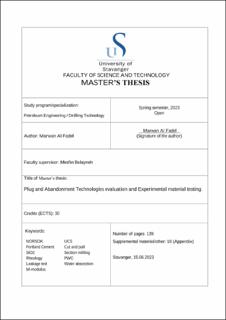| dc.description.abstract | Abstract
The conventional method to plug and abandonment (P&A) is characterized by its time-consuming nature, high costs, and associated challenges and risks related to Health, Safety, and Environment (HSE) considerations. In recent years, there has been a growing focus on P&A operations to enhance efficiency and reduce costs. Furthermore, cement plays a critical role in the P&A process, and any failures in its performance can result in various issues such as loss of zonal isolation, loss of wellbore integrity, and potential leakage.
This thesis examines the performance and challenges associated with conventional plug and abandonment (P&A) technologies, including cut and pull, section milling, and perforate, wash, and cement (PWC). Case studies are presented to assess the P & A technologies. Moreover, new alternative technologies, solutions, and tools that aim to improve P&A operations are reviewed. This thesis also experimentally investigated the impact of using nano-SiO2 in G-class cement with a 0.44 water-to-cement ratio (WCR).
The findings from field trials and laboratory research indicate that alternative technologies, solutions, and tools have demonstrated promising improvements in performance and effectiveness. However, it is necessary to conduct further research and establish performance guidelines before implementing these alternatives. Based on the considered case study, PWC demonstrated significant time savings, with a 65% reduction in operational time compared to section milling and a 70% reduction compared to cut and pull operations. Moreover, the addition of an optimal dosage of 0.242 wt. % SiO2 (by weight of cement) resulted in a significant increase in the uniaxial compressive strength (UCS) of neat cement. After 3 days and 28 days of curing at atmospheric pressure and temperature, the UCS improved by 39.53% and 24.88%, respectively. Additionally, the optimal SiO2 reduced the water absorption of the neat cement, by 15.00% after 3 days and 20.14% after 28 days cured at 105oC and atmospheric pressure. | |
